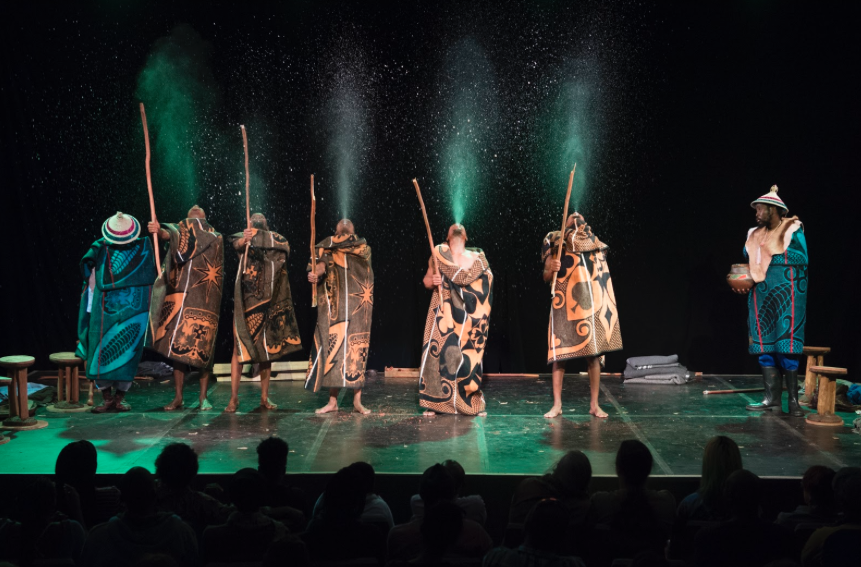In 1974, an inaugural festival titled the 1820 Settlers National Monument was opened as a memorial to the British immigrants in South Africa. They established the tradition of celebrating landmark anniversaries on a grandiose scale and presented the space as a “living” monument in which festivals, conferences and other gatherings were held. The concept would grow to become a celebration of South African art and heritage and thus became known as the National Arts Festival (NAF) and has been active annually since, with the exception of 1975 due to political upheavals.
The project, which was an undertaking of the Grahamstown foundation for 28 years, became a section 21 company in 2002 with an independent board of directors. It operates out of the 1820 Settlers National Monument in Grahamstown and rents out office space as well as performance facilities. The NAF is one of the oldest cultural events in South Africa, having run for over 40 years and it has also become one of the largest and most important celebrations of the arts on the African continent.
It has been open to all regardless of race or sex, and has never imposed artistic restraint or censorship on participants, instead it served as an important forum for political protest theatre and resistance art during the height of the apartheid era, and it still offers an opportunity for experimentation and innovation across the arts.
 Tau performed by One Man and His Dog and The Market Theatre Photograph by Jan Potgieter Image source
Tau performed by One Man and His Dog and The Market Theatre Photograph by Jan Potgieter Image source
The Festival
The festival runs for 11 days between the end of June and beginning of July, attracting crowds that almost double the population of Grahamstown with programmes that consist of drama, dance, music, visual art, film and many other art forms and activities. In a bid to engage with a wider audience and attract more local residents, the festival programme is conducted in many different local facilities and art spaces. Over 50 spaces across Grahamstown are used, among them are Yellow House on High Street, Kingswood College on Burton Street and The Old Gaol on Somerset Street.
Upon its inception, there were 64 main events on the programme, ranging from theatre productions, workshops, lectures and tours. Today NAF hosts more than 360 events with over 1200 performances. There is even a crafts fair called Village Green that runs everyday for the duration of the fair, and that boasts some of South Africa’s best craftwork and craft artists.
The NAF is comprised of a main festival as well as a Fringe programme, which are both administered by the National Arts Festival offic
The Fringe
The Fringe programme was introduced in 1979 as an open-access event for performers, and, unlike the main programme, Fringe had no selection criteria although participants are responsible for their own costs and 85% of their box office sales accrue to them directly. The Fringe began with just ten events, but it has since grown to host over 369 today. Seasoned performers and famous directors are often found on either the main or Fringe programme, with many that found their voices on the Fringe stage returning to stage new and old productions.
The National Arts Festival’s Fringe attracted sponsorship from the National Lottery Commission (NLC) when the NAF partnered with the institution in 2016. The sponsorship contributes to the logistics, overheads, artistic budget and marketing of the event. As a result, the event has since been renamed the National Lottery Fringe.
The sponsorship makes it easier for artists to see a profit as the investment of R10 million in 2016 saw the Fringe artists receiving R1000 of their venue hire costs as part of the agreement.
Some highlights of the many productions on offer at the 2016 Fringe include the independent Johannesburg theatre group POPArt’s crowd pleasing play, We didn’t come to Hell for the Croissants by Jemma Kahn, that had returned to the Fringe after a successful 2015 debut, The Very Big Comedy Show IV which featured big-name Fringe artists such as Rob Van Vuuren, Tumi Morake and Mark Lottering, as well as Intwaso, an indigenous dance presentation by Isingqi Sakwa-Ntu cultural group which explores the journey of becoming a traditional healer.
The festival relies on sponsorship from the Eastern Cape Government, Standard Bank, the National Lotteries Commission, the National Arts Council, Transnet, City Press newspaper and MNet. The NAF continues to provide a platform for artists to express new forms of art as it is a forum for new ideas and is seen as an indicator of future trends in the art world.